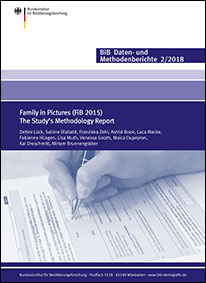Miscellaneous PublicationsFamily in Pictures (FiB 2015): The Study’s Methodology Report
Lück, Detlev; Diabaté, Sabine; Zehl, Franziska; Book, Astrid; Macke, Luca; Hüsgen, Fabienne; Muth, Lisa; Gnoth, Vanessa; Dupeyron, Maica; Dreschmitt, Kai; Brunnengräber, Miriam (2018)
BiB Daten- und Methodenberichte 2/2018. Wiesbaden: Bundesinstitut für Bevölkerungsforschung

URN: nbn:de:bib-dmb-2018-020
The study “Family in Pictures” was conducted by the Federal Institute for Population Research (Bundesinstitut für Bevölkerungsforschung – BiB) in 2015. It aims to capture and describe in detail the individual and cultural family-related cultural conceptions (“leitbilder”) of the participants. The study uses a multi method approach comprising three techniques of data-collection: (1) The participants were asked to draw a picture of a “proper” family. (2) With every participant a personalised semi-structured telephone interview was conducted with the intention to interpret this drawing accurately. (3) Participants filled out a standardised short PAPI (“paper-and-pencil-interview”) questionnaire concerning their basic socio-demographic characteristics as well as their current and past family situation. The target population of the survey is the resident population of the Federal Republic of Germany with German citizenship, at the age of 16 years or older. Based on quota sampling and snowball technique, a gross sample of 136 persons was generated, who had expressed interest in participating in the study and to whom according documents were sent. By the end of the fieldwork, between February and October 2015, data was successfully collected for a net sample of n = 101 persons.








